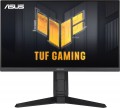Surface treatment
Modern monitors can use displays with both glossy and matte screen surfaces.
A matte surface is in some cases more preferable due to the fact that on a
glossy screen, when exposed to bright light, noticeable glare appears, sometimes interfering with viewing. On the other hand, glossy screens offer better picture quality, higher brightness, and richer colours.
Due to the development of technology,
monitors with a special anti-glare coating have appeared on the market, which, while maintaining all the advantages of a glossy screen, creates significantly less visible glare in bright ambient light.
Refresh rate
The maximum frame rate supported by the monitor at the recommended (maximum) resolution.
The higher the frame rate, the smoother the movement on the screen will look, the less noticeable jerks and blurring will be on it. Of course, the actual image quality also depends on the video signal, but for normal viewing of video at a high frame rate, the monitor must also support it.
When choosing this option, keep in mind that at lower resolutions than the maximum, the supported frame rate may be higher. For example, a model with a 1920x1080 matrix and a claimed frame rate of
60 Hz at a reduced resolution can give 75 Hz; but the
75Hz frame rate is only listed in the specs if it is supported at the monitor's native (maximum) resolution.
Also note that a high frame rate is especially important for gaming models (see "Type"). In most of them, this figure is
120 Hz and higher;
monitors with a frequency of 144 Hz are considered the best option in terms of price and quality, however, there are also higher values —
165 Hz and
240 Hz. And
monitors at 100 Hz can be both inexpensive gaming models and advanced home ones.
You can evaluate all the frame rates at which this monitor is capable of operating by the ver
...tical frequency claimed in the specifications (see below).Vertical viewing angle
This parameter determines in which sector in the vertical plane relative to the monitor screen the user's eyes must be in order to see pure, undistorted colours on the screen. For example, a viewing angle of 170° means that the width of such a sector is 170°; the middle of the field of view, usually, is a line perpendicular to the screen. The larger the vertical viewing angle, the higher or lower relative to eye level you can place the monitor without tilting it.
Horizontal viewing angle
This setting determines in which sector of the horizontal plane relative to the monitor screen the user's eyes must be in order to see pure, undistorted colours on the screen. For example, a viewing angle of 170° means that the width of such a sector is 170°; the middle of the field of view, usually, is a line perpendicular to the screen. The larger the horizontal viewing angle, the more aside from it the observer can sit; large viewing angles are especially useful when there are several people behind the monitor at once, for example, when watching a movie.
Colour depth
The colour depth supported by the monitor.
This parameter characterizes the number of shades that the screen can display. And here it is worth recalling that the image in modern monitors is based on 3 basic colours — red, green, blue (RGB scheme). And the number of bits is indicated not for the entire screen, but for each base colour. For example, 6 bits (the minimum colour depth for modern monitors) means that the screen is capable of producing 2 ^ 6, that is, 64 shades of red, green and blue; the total number of shades will be 64 * 64 * 64 = 262,144 (0.26 million). An
8-bit colour depth (256 shades for each base colour) already gives a total of 16.7 million colours; and the most advanced modern monitors support
10-bit colour, allowing you to work with more than a billion shades.
Screens with support for FRC technology are worth a special mention; nowadays, you can find models marked "
6 bit + FRC " and "
8 bit + FRC ". This technology was developed to improve picture quality in situations where the incoming video signal has a greater colour depth than the screen, such as when 10-bit video is fed to an 8-bit matrix. If such a screen supports FRC, the picture on it will be noticeably better than on a regular 8-bit monitor (although somewhat worse than on a full-fledged 10-bit monitor, but “8 bit + FRC” screens are much
...cheaper).
High colour depth is important primarily for professional graphics and other tasks that require high colour fidelity. On the other hand, such features significantly affect the cost of the monitor. In addition, it is worth remembering that the quality of colour reproduction depends not only on the colour depth, but also on other parameters — in particular, colour gamut (see below).Portrait pivot
The screen is 90° rotatable on a stand, from landscape (horizontal) to portrait (vertical). The vertical orientation of the screen (
portrait mode) can be useful, for example, when working with large documents made in portrait orientation.
Screen swivel
The presence of
a swivel stand in the design of the monitor allows you to change not only the angle of the screen (of course everyone has it), but also its rotation to the right and left. The angle of rotation depends on the model, but anyway, even a slight deviation allows you to quickly adjust the position of the monitor to your needs.
Height adjustment
The ability to move the monitor screen up and down relative to the base. This feature is very convenient for
adjusting the height of the screen — moving it on the mount is much easier than looking for a stand or resorting to other tricks.

